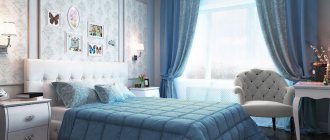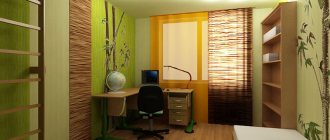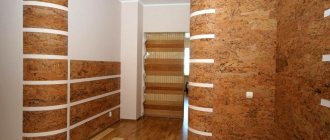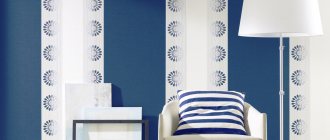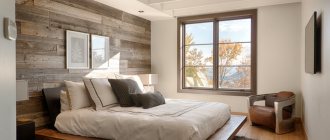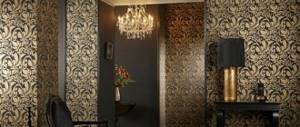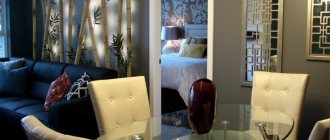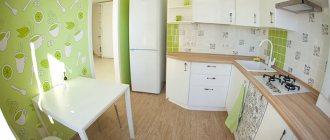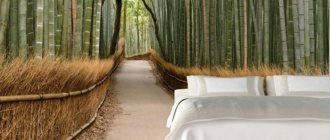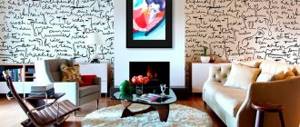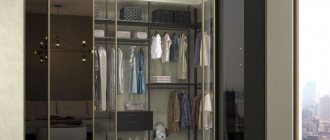The benefits of cork wall coverings
Various types of coatings are made from cork, but they all have the following properties :
- Eco-friendly;
- Not flammable;
- Durable;
- Do not accumulate static charges;
- They look stylish and elegant;
- Do not gather dust;
- Not susceptible to fungus even in damp rooms;
- Mask surface defects;
- They have excellent heat and sound insulation;
- They do not lose their attractive appearance for a long time;
- The coating is easy to care for.
How to glue cork wallpaper
Buy quality glue . The products of Multifix (Italy) have earned good reviews. Cost: 860 rub. for 4kg. Glue consumption: about 350 g per 1 sq.m.
Tools for gluing cork wallpaper:
- A roller used to apply glue;
- Scissors;
- The second roller is designed to smooth the surface;
- Thin brush.
Stages of work:
- Surface preparation . The wall is leveled and cracks are sealed. They putty and level the wall. At the end - primer. The result is a dry, smooth and clean wall;
- is cut to size. The room must be dry. When gluing cork, drafts are not allowed;
- The glue is poured into a special container with wide edges. To understand whether it is better to apply glue to the wall or to the wallpaper itself, or to both surfaces, carefully read the instructions on the package you purchased. The manufacturer indicates how to proceed;
- Rolls are glued end to end . The panels should fit tightly to each other. Gluing cork wallpaper is done by two people - wet cork wallpaper is easily torn;
- Carefully glue the coating in the corners to avoid tears and cracks;
- The seams are sealed using glue , which is applied with a thin brush. A roller is passed along the seam to press the wallpaper to the wall;
- Excess material is cut off with scissors . Do not use a knife, as it easily tears glue-impregnated fabrics.
Interested in glass mosaic? Then read our next article. And here is an article that will tell you about plasterboard arches.
Types of cork wall coverings
Depending on the type of base on which the veneer is glued, there are:
- Cork wallpaper on a paper base with a decorative veneer layer no more than 1 mm thick. The length and width of the canvas are standardized and equal to 10 m and 0.5 m, respectively.
- Cork covering for walls on a non-woven basis . The thickness reaches 2-3 mm, the width varies from 0.3 to 1 m, and the length is most often 5.5 m, but you can also find rolls with a length of 10 m. More wear-resistant, durable and durable compared to paper cork.
We recommend: Linoleum for walls: new in the traditional
There are also baseless wallpapers made of cork. However, cork in its pure form is used extremely rarely, since it is not durable enough and is quite expensive.
The length of the strip does not exceed 5.5 m. Cork wallpaper on a paper basis does not differ in phenomenal strength, but in general the value of the indicator is much higher than that of baseless canvases.
You can also find self-adhesive cork-based wallpaper on sale. Structurally, they consist of decorative veneer, on the reverse side of which an adhesive layer is applied, protected by a film.
The scope of their application is not limited to wall decoration. Can be used to decorate furniture, kitchen aprons or other surfaces.
According to the form of release, several separate groups are distinguished:
- Cork wallpaper for walls in rolls . Can be found in raw or already painted form.
- Sheet cork, which is mats with dimensions of 0.5´1 m and a thickness of 3-5 mm.
- Cork covering for walls in the form of panels with a thickness of 3 mm and parameters of 0.3´0.3 m and 0.6´0.6 m.
Cork wallpaper, the price of which ranges from 600 to 1500 rubles. per m2, are known for their porous structure, which is moderately resistant to contamination. For greater moisture resistance, they are treated with wax or a special coating that does not create a barrier to air exchange.
Cork wallpaper for walls. Prices and reviews
Cork wallpaper is produced both on a paper base and without it. A coating that has a base is much easier to glue. Baseless coating is cork that has been crushed and compressed. It is this coating that gives you coolness in the heat, and in winter it allows you to increase the temperature by 3-4 degrees.
All shades of brown, beige, sand, and gold will make any room warm and conducive to a pleasant time.
Cork flooring is quite expensive. But the cost is justified by the high performance, environmental friendliness, long service life and high decorative effect that these natural materials provide.
There are also more budget-friendly coverage options. The price depends on the reputation of the manufacturing company, the presence or absence of a base, and the type of coating. Self-adhesive cork wallpaper will cost more than adhesive wallpaper. If wax is applied to the surface, the cost and service life increase.
How much do cork wallpapers cost and which ones to choose? Natural cork wallpapers produced by the following companies have proven themselves well:
- Wicanders (Portugal) 330-360 rub. per sq.m;
- Egen (Portugal) 305-700 rub.sq.m;
- Granorte (Portugal) 310-811 rub.sq.m;
- Ibercork (Portugal) 225-700 rub. per sq.m;
- Articor (Spain) 305-400 rub. per sq.m
Reviews from those who have used cork wallpaper in their interiors are mostly positive:
Anna. Moscow.
I have long dreamed of making my large living room different from others and very cozy. I wanted the material to be environmentally friendly. The designer suggested cork wallpaper.
I don't really like natural colors, but I still agreed. I don't regret it. Beautiful, stylish, very cozy. The living room looks very noble;
Eugene. Saint Petersburg.
I chose Ibercork baseless cork wallpaper rolls from Portugal. I asked the builders how they stuck together. It turned out to be quite difficult.
I was captivated by the fact that in summer the cork on the walls protects from the heat (our place, of course, is not very hot), and in winter it adds about 4 degrees. Indeed, in cold weather the temperature of the house is higher than it was before the room was covered with cork. I recommend it to those whose apartment is cool. They also look beautiful.
Boris. Tver.
And I like to listen to music loudly, I love bass. The neighbors were shocked by me. A music lover friend advised me to stick a cork on the walls. I took Egen. The price is quite reasonable. Its sound insulation is excellent. Neighbors complain less.
The cork also looks very impressive. In the hallway I made inserts from cork slabs. Friends appreciated it. Advice: glue only with an assistant.
Wallpaper
-1 vote
+
Vote for!
—
Vote against!
Wallpaper is one of the most popular materials for interior decoration. There are more than ten types of them. Cork wallpaper is a natural, environmentally friendly material. They create a cozy and comfortable indoor microclimate. Cork fits perfectly into any interior from classic to rustic style. We'll talk about installation features, advantages and disadvantages of cork wallpaper further.
Table of contents:
- Benefits of cork wallpaper for the home
- Characteristics and types of cork wallpaper
- Cork wallpaper photos and scope of use
- How to choose cork wallpaper for your home
- Tool for installing cork wallpaper
- Preparing walls for gluing sheet cork wallpaper
- Do-it-yourself gluing and installation of cork wallpaper
Benefits of cork wallpaper for the home
To make cork wallpaper, natural cork is used, that is, oak bark. Cork oak is popular in countries such as Italy, Portugal, and Spain. This material has a porous structure, due to which it has unique physical characteristics, such as:
- high strength;
- excellent heat and sound insulation characteristics.
The wallpaper manufacturing process involves grinding the bark, pressing and heating. When the cork is exposed to temperature, a resin begins to release, which glues the material together. It is thanks to it that the material takes on a roll or sheet form.
Another option for cork wallpaper is with a backing. The previously prepared cork mass is applied to a thick paper or non-woven base. In the process, patterns or textures are created; to further decorate the coating, color pigment is added to it.
The first and most important advantage of cork wallpaper is its environmental safety. The material is absolutely harmless and even good for health. Wood is an excellent regulator of indoor humidity and has a beneficial effect on the microclimate.
Among the advantages of wallpaper made from cork, we note:
- high level of reliability and strength - resistance to mechanical damage;
- the presence of wax impregnation ensures dirt and dust resistance, practically no marks remain on the wallpaper;
- do not require special care or washing;
- have good soundproofing characteristics;
- the thermal insulation properties of cork wallpaper allow you to maintain optimal microclimatic conditions in the room;
- the attractive appearance of the wallpaper is ensured by the unique natural pattern created by the material;
- the absolute safety of the material expands the scope of its application; cork wallpaper is an ideal option for a child’s room, since the coating is hypoallergenic and allows air to pass through well;
- cork has antiseptic properties, mold does not form on it, insects and microorganisms do not grow on it;
- cork wallpaper does not fade and tolerates direct sunlight;
- the material is not prone to burning due to the application of special impregnations.
Cork wallpaper goes well with different types of tiles, natural and artificial stone. The material is pleasant to the touch, makes the room cozy and comfortable.
Despite this, cork wallpaper has certain disadvantages. To apply wallpaper, you need to prepare a perfectly flat surface. Since the sheets are quite heavy, at least two people install them. The cork covering adheres firmly to the wall, and if it is necessary to dismantle the covering, problems arise. Cork wallpaper has a limited range of colors and colors, most of them are natural, matching the color of wood. The cost of wallpaper is quite high compared to similar finishing materials, however, this disadvantage is compensated by its long service life.
Characteristics and types of cork wallpaper
In relation to the composition, cork wallpaper is divided into:
- baseless type coating - consists exclusively of cork, such canvases have only a roll base, are highly fragile and lower cost;
- cork wallpaper with a paper or non-woven base - denser in thickness, available in rolls of 550 cm, characterized by good ductility, ease of installation, and does not crumble, compared to the previous version;
- slab versions of cork wallpaper - they are more expensive, have standard dimensions of 3 by 6 cm, and are easy to install;
- cork wallpaper on a self-adhesive base - suitable for wooden surfaces, walls made of fiberboard or plywood, differs by the presence of a backing.
Cork slab wallpaper contains one or more layers of cork. They are processed using grinding equipment. There are wallpapers with colored splashes and painted cork plates. For the bathroom, wax-coated slabs are used. In addition, this material is often used to decorate the ceiling.
Cork has a natural porous structure; the material is stain-resistant, but absorbs moisture. It is not recommended to glue cork wallpaper in the kitchen or bathroom. Wax impregnation or a special vapor-permeable varnish gives the coating additional moisture resistance. The cost of such wallpaper is slightly more expensive than regular wallpaper.
Cork wallpaper photos and scope of use
The material has universal characteristics, therefore it has a wide range of applications. Cork wallpaper options are used:
- for decorating children's rooms - due to its environmental safety, natural composition, and resistance to dirt, this material is an ideal coating for a room where children live;
- in the living room and bedroom, cork wallpaper creates cozy and comfortable conditions for rest, relaxation and receiving guests;
- since wallpaper is resistant to mechanical stress, it is often installed in the hallway;
- Wallpaper with an additional wax coating is used in rooms with high humidity, such as the bathroom and kitchen.
In addition, cork is an excellent option for finishing public spaces: restaurants, cafes, shops, cinemas, etc. The too high cost is fully compensated by good performance characteristics.
How to choose cork wallpaper for your home
Cork wallpapers are quite expensive, so their choice must be approached with special responsibility. We recommend giving preference to trusted manufacturers with a good reputation. Some of them provide product warranties.
When choosing wallpaper, carefully inspect the packaging; the structure of the material should be uniform. Do not choose wallpapers that are too thick, as they are more fragile.
If you have a choice between baseless wallpaper and paper or non-woven material, we recommend giving preference to the second option. Cork wallpaper without a base is practically not used due to its increased fragility.
Paper-based cork wallpaper rolls are lightweight, increased strength, and easy to install. The material is most often produced in the form of rolls.
Non-woven wallpaper is more durable and wear-resistant. Their cost is slightly higher, but it is fully compensated by their performance properties.
In relation to the color palette, cork wallpapers do not have much variety. The color range is limited to yellow, brown and their shades. Choose a color in relation to the style parameters of the interior design.
Choose wallpaper with detailed instructions from the manufacturer. Require certificates confirming the quality and environmental safety of products.
Immediately select an adhesive composition for cork wallpaper. Solutions like PVA glue are too weak and will not hold the fabric properly. Choose special compositions for cork wallpaper; some manufacturers indicate recommendations on the type of adhesive for certain wallpapers.
Tool for installing cork wallpaper
To hang cork wallpaper, you need the following tools:
- construction plumb line or level - with its help they control the quality of work;
- rulers with pencil;
- stationery knife for cutting wallpaper;
- a tool for applying glue, most often a comb-shaped spatula;
- containers for glue;
- clean rags - for leveling wallpaper;
- roller - it is used to process seams;
- glue for cork wallpaper.
When choosing glue, we recommend choosing a composition with an acrylic base. The instructions for the glue indicate the proportions and method of application. Most often, the composition is applied both to the wall and to the wallpaper. To set the glue, press the wallpaper against the surface for a long time. It is not recommended to use glue that contains water.
Preparing walls for gluing sheet cork wallpaper
Pre-clean the wall from the previous finish. Level the walls and repair cracks. Any irregularities or depressions will be visible after gluing, so you need to get rid of them. In addition, the presence of unevenness leads to peeling of the wallpaper. The maximum difference is 2-3 mm.
If the condition of the walls is satisfactory, then it is enough to use ordinary gypsum-based putty to finish them. If there are irregularities of more than three millimeters, the walls are first sanded, then puttyed and completely grouted.
After the putty has dried, the surface is sanded with a mesh or a special machine. After this, clean the surface from dust and apply a primer. This composition reduces the absorption of glue and improves adhesion between the wallpaper and the wall. Wallpapering work is carried out at an optimal humidity of 50% and a temperature of 18-24 degrees. Before gluing cork wallpaper, it must be kept in the room where repair work is being carried out for at least 24 hours. Thus, the coating will acclimatize and take the desired shape. Otherwise, there is a risk of deformation, swelling or warping of the coating.
Do-it-yourself gluing and installation of cork wallpaper
Initially, prepare all the tools for work and start cutting the canvas. In order not to lose precious centimeters of material, make markings on the walls and, in relation to it, determine an economical cutting scheme. When creating markings on walls, use a level.
The most difficult part is cutting the cork wallpaper. Cork is a rather fragile material; cutting it requires a sharp knife. Otherwise, the cuts will be sloppy. Place the wallpaper on a solid base and cut it on it.
Pre-arrange the cutouts for shaped elements in the form of sockets and switches. Cork wallpaper is glued taking care of the joints, the seams are processed using a special roller, the result should be a perfectly continuous surface.
If the contact version of the glue is used for work, then follow the instructions below for installing cork wallpaper:
- apply glue to the surface and level them;
- cover the underside of the wallpaper with glue;
- leave them for 10 minutes;
- Start gluing the wallpaper from the bottom, gradually moving to the top.
When working with cork wallpaper, consider the following factors:
1. In corner areas, cork wallpaper does not bend, as it is impressively thick. The two canvases fit tightly together.
2. Be especially careful while working, as glue that gets on the outer part of the wallpaper is almost impossible to remove.
3. After work, apply a wax or varnish coating to the wallpaper.
There are two methods of wallpapering:
- vertical;
- horizontal.
In any case, the key to successful wallpapering is the correct marking of the walls and cutting of the canvases. Wallpaper should be laid starting from the corner or floor. To cut off excess wallpaper, use scissors, as it is quite difficult to do this with a knife. If there are air bubbles, remove them by puncturing them with a needle, while using a syringe, carefully pour glue inside.
The drying time for wallpaper based on cork is about 48 hours; during this time, the presence of drafts in the room is unacceptable. The service life of the coating is 12-15 years. After installing the wallpaper, be sure to coat it with vapor-permeable varnish. If there are stains, they are removed with sandpaper.
Installing cork wallpaper video:
Cork wallpaper in the interior. Photo
Some people think that cork is a boring and uninteresting material. They are deeply mistaken. A wine bottle stopper has nothing to do with a luxurious, interesting, elegant finish.
Manufacturers offer so many different shades, patterns and textures that you can create real masterpieces of design. Look how many interiors that are completely different in style and design have been created using cork.
Cork wallpaper. A small photo gallery.
Photo: Cork wallpaper in the hallway interior.
Wall finishing with plasterboard. Watch the video and article about this, read here. And in this article you will be taught how to properly glue wallpaper onto drywall.
Properties, advantages and disadvantages
The main characteristics of the cortical material:
- sound and heat insulation properties are due to the porous structure of the coating;
- stability of natural color to natural light;
- antistatic – due to this property, the material does not attract dust;
- light weight;
- elasticity - this property allows you to hide the imperfections of the walls;
- elasticity – thanks to this feature, the material is resistant to impacts;
- cork can resist the formation of fungus;
- this is a non-flammable material.
The characteristics considered make the cork coating universal and allow it to be glued to walls, floors and other surfaces. The use of such wallpaper in the interior is due to their advantages, which manifest themselves during operation:
- environmental friendliness;
- universal coating (can be used in the interior of a hallway, bedroom, nursery and any other room);
- ease of maintenance, which is explained by the possibility of using any surface cleaning methods (vacuum cleaner, damp rags and even sandpaper);
- resistance of the material to fat, odors, moisture;
- the possibility of long-term operation is due to the resistance of the coating to solar radiation;
- the use of cortical material allows you to protect yourself and your neighbors from extraneous noise;
- cork retains heat well in winter and makes the room cool in summer, which means that wallpaper made from this material allows you to create an acceptable microclimate in the room;
- Due to the elasticity of this coating, there is no need for careful preparation of the base, since the wallpaper hides minor irregularities well.
Self-adhesive cork wallpaper for walls
This type of cork covering was created in order to make finishing work as easy as possible and speed up the process. Such wallpaper is very popular for decorating kitchens and bathrooms. Such wallpapers are suitable not only for decorating walls, but also for furniture, doors, and other surfaces.
Self-adhesive cork wallpaper is paper on which cork veneer is applied. Its thickness may vary. A decorative pattern is often made on top of it. On the inside, the wallpaper is covered with a layer of glue, which is protected by a special film.
Gluing such wallpaper is very simple. The surface is leveled and cleaned of dust. You need to remove the protective film and press it well, and then smooth the wallpaper with a rubber roller to remove any air bubbles that have arisen. If in the end some bubbles remain, poke them with a needle and smooth the surface again. Important: connect the joints carefully.
Self-adhesive cork covering is produced in brown and beige tones. New items: coatings in bronze and gold shades. The structure is very diverse: from crumbs with small grains to plates of different sizes.
The appearance of coatings with different textures is radically different from each other. The refined, luxurious, eco-friendly interior will delight your guests.
Characteristics
The presented material has general properties, regardless of the canvas, highlighting the qualities of oak wood, and has more advantages, having practically no disadvantages or significant negative aspects. All models undergo decorative and protective treatment, both paper and non-woven fabrics.
- Moisture resistance. Veneer withstands humid environments well, repels water and dirt, all types can be washed and wiped clean. Maintenance is carried out with a simple wet cloth, easily removing minor dirt. To improve this ability, they can be additionally treated with wax or varnish; this technique is performed on aprons or places where water gets in.
- They do not absorb odors, thanks to a protective barrier implemented in production, which is inherent in each model, regardless of the base. And they withstand temperature changes well, therefore, they are suitable for kitchen areas.
- Decorative qualities. They are distinguished by a noble appearance, with pleasant shades. The color palette has been expanded, providing a huge variety. They are distinguished by high tactile properties, the texture is soft and pleasant to the touch. The relief is set during production, how the decorating particles are laid, this is the appearance that is obtained. There are smooth and also ribbed coatings, and with some wood imitation images or individual patterns.
- Ecological cleanliness. Natural ingredients are used in production, making them safe, do not emit odor and do not provoke allergies. Harmless to humans.
- Sound insulation and heat insulation properties are average. If we compare them with traditional wallpaper, they block noise much better and retain heat more effectively. A thin layer cannot provide increased properties of these parameters, as is the case with cork types or panels.
- Thanks to special impregnation, they not only are not afraid of water and odor, but also prevent the growth of microorganisms, fungus or mold.
- Service life. Without external influences, they can last several years, up to 10 or more. They are not afraid of ultraviolet radiation, so they do not fade for a long time, maintaining their original appearance. They are dense, yet soft, susceptible to scratches under strong pressure.
Also read: Brick wallpaper; description of types and examples of finished interiors
Let us highlight some disadvantages to warn against unpleasant consequences.
- Weak resistance to prolonged physical impact. Can scratch, especially in cases where you keep pets, softness attracts cats. When planning a design, it is better to avoid high-traffic areas, replacing them with other more durable building materials, and additionally cover certain areas with protective compounds during repairs. Also, do not hang heavy objects on them or rest them against anything for a long time, as dents may remain.
- High price. Among roll wallpapers, they are considered a premium type. Among cork coverings, they are the most inexpensive way to frame walls; compared with other cork canvases, you will not lose aesthetically, but the strength properties are much lower than those of panels.
- Tapestries on paper are not suitable for loggias, showers, dressing rooms, bathrooms, in other cases they are glued everywhere, including in the kitchen. It is especially important to avoid areas with direct contact with moisture, sinks, aprons.
Wherever you get information, know that wallpaper without an agglomerate layer cannot create high thermal insulation and sound insulation, it is thin, and behaves like other dense wallpaper, with slight superiority on these points.
If you want to increase the sound insulation of an apartment or individual rooms, purchase wallpaper with an additional layer of agglomerate; they have increased noise blocking properties and dampen minor vibrations, but when compared with panels, they are significantly inferior.
Cork rolls for walls
Cork coverings in rolls contain crushed and pressed crumbs.
Some people believe that rolls and cork wallpaper are the same thing. There is a difference :
- Wallpaper has a non-woven or paper base. It's easier to glue them. Get wet when applying glue;
- The rolls are made only of cork, the coating thickness is about 2 mm. Has excellent thermal insulation properties. Sound insulation – high. You can't handle them without special glue.
More about manufacturing technology
Cork wallpaper for walls is made from tree bark. However, any raw material is not suitable for this purpose. The specific appearance and properties are due to the fact that the bark of the cork tree is used in production. This material is characterized by a microporous structure. Thanks to this feature, cork coverings allow air to pass through well. Previously, the thickness of such material was significant, so it was difficult to imagine that over time it would be possible to cover the walls with cork.
To understand how this became possible, you need to understand the intricacies of manufacturing technology. The basis of production is a special kind of raw material. Sawdust from cork wood is used. The crushed material is compressed. However, it is not enough to simply compact the raw materials. To keep it in a certain shape, you need a composition that holds the sawdust together. Only synthetic glue is not used in the production of cork wallpaper. This makes the material environmentally friendly. But how to achieve the required density and reliability?
Cork wallpaper for walls is made from tree bark
The thing is that during production, raw materials release specific substances (resins). This occurs under the influence of high temperatures. Plant components allow the fibers of cork sawdust to firmly adhere to each other. If a base is used, then using the same technology the compressed raw materials are firmly bonded to it.
Technical cork in rolls
Cork coverings perform not only a decorative function. The choice of application area is influenced by the thickness of the sheet.
Technical rolled cork of 2-4 mm is needed for heat and sound insulation of walls and floors. Cork thickness from 6 to 10 mm is suitable for use as a substrate when laying laminate, carpet or linoleum.
Rolled cork with a layer thickness of 10 to 100 mm is suitable as a shock absorber of various vibrations, insulation and soundproofing material. This type of coating is called cork agglomerate.
Wooden wall panels. Read about it here. And here is an article about mirror mosaics.
See our website. And you will learn a lot more informative, useful information.
